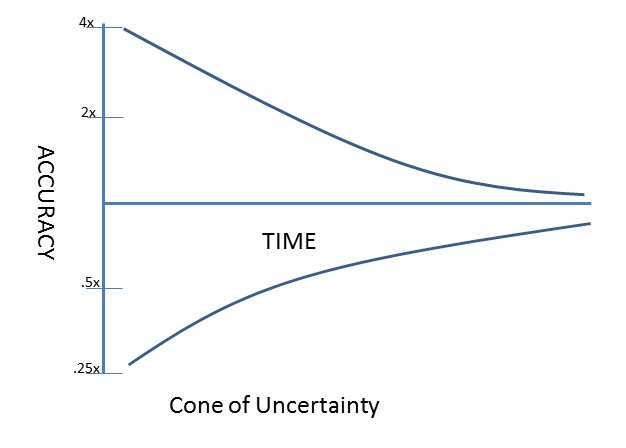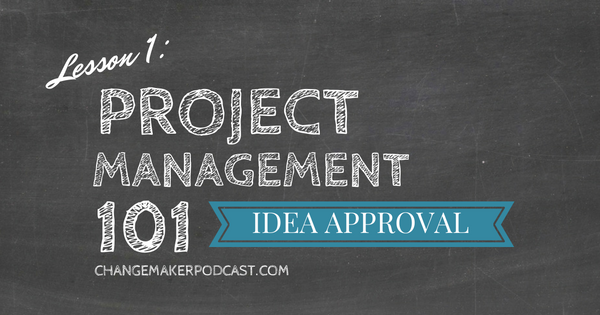Get more good stuff.
How to Manage a Project
This is the first of a series of posts sharing the basics of how to manage a project. The information is intended for anyone who wants to understand the core concepts, even if you have little project management knowledge. Regardless of if you’re managing a project yourself or hiring out the work, I want this content to help you make your next projects more successful!
Why is Project Management Necessary?
Project management is necessary because it gets results. Think of some of the projects that you have done or plan on doing – maybe launching a new service or product, hiring your first employee, remodeling, hosting an event, designing a flyer, or building a website. By improvising or “winging-it”, projects are often over budget, past deadlines, and the results may not really be what we wanted in the first place. We want to get things done and reach our goals – having clear objectives and a solid process helps us to do just that.
What is a Project?
Let’s start at the beginning with defining what a project is. To me, a project is simply “a planned set of tasks to reach a goal.” “Planned” means that there has been thought given to what you want to achieve and how you want to achieve it. “Set of tasks” implies that there is a beginning and an end, meaning that ongoing operations and day-to-day activities are not projects. And a “goal” means that a clear result will be delivered when the project is done.
Typically projects are efforts that involve a degree of complexity or risk, months of work, a substantial cost, or impact a number of people. Purchasing a new laptop for your workplace involves a set of tasks, a goal, and may be expensive, but the steps are straightforward and don’t need to be closely managed.
Now that we’re all on the same page, here are the 5 key steps to managing a project:
- Idea Approval – What do you want to do? Why?
- Plan – How are you going to do it?
- Execute – Let’s get it done!
- Check and Control – Keep the project on track.
- Close – Wrap up the project.
For today’s post, we’ll start with item # 1, Idea Approval, and answer “What do you want to do? And Why?”
Idea Approval – What do you want to do? Why?
Since none of us have unlimited amounts of time, money, and people, it’s critical to spend effort on things that really matter. By investing a small amount of time up-front, you’ll know if the project is worthwhile and you will prevent the costs of working on the wrong thing.
 As we walk through this phase, let’s fill in the details as if we’re starting a project to build a brand new website for our adventure travel business (think new cultures, exotic locations, and exciting events – who’s with me??!). I consider this to be a small to mid-size project, so I will fill out the info as such. Depending on the size and complexity of your project, you can select how much effort you will put in to filling out this initial information.
As we walk through this phase, let’s fill in the details as if we’re starting a project to build a brand new website for our adventure travel business (think new cultures, exotic locations, and exciting events – who’s with me??!). I consider this to be a small to mid-size project, so I will fill out the info as such. Depending on the size and complexity of your project, you can select how much effort you will put in to filling out this initial information.
The Idea Approval phase can be broken into 3 parts.
- We’ll first start with WHY a project is needed by defining the need and available solutions.
- Then we’ll answer WHAT the project includes with a scope statement, risks, and issues.
- Last we’ll look at WHEN, HOW, and WHO by creating an initial schedule, reviewing costs, and determining roles.
1. WHY a project is needed:
Business Need or Problem Statement:
Write a brief description of the need or problem so anyone can understand without having prior knowledge.
Example: ABC Adventure Travel needs to have an online presence to provide better customer service, improve efficiency, and attract new customers. 60% of incoming phone calls are spent answering basic questions that could be available online. Most competitors have websites and research has shown that 90% of customers in this market use online information to make decisions about adventure travel. Without being online, ABC Adventure Travel is not providing excellent customer service, it’s wasting time and money on phone calls, and it is missing the opportunity to serve new clients who may be searching for solutions online. (typically you would show data to support these figures).
Recommended Solution and Benefits:
List your recommended solution and why. Specifically, how this project will help your business – things like ROI, cost avoidance, satisfying regulations, new markets reached, etc. Also describe how the project aligns with your strategic plan.
Example: The recommended solution is to build a responsive website that works on all computers and mobile phones. If the phone call volume can be reduced by 50% after a website is set up, the ROI is projected to be 3 months. Additionally, the website should attract more customers; initial projections show a monthly customer increase of 5%. (typically you would show data to support these figures). This aligns with our strategic objectives to grow into new markets and increase productivity.
Alternative Solutions:
List alternative solutions and why they are not preferred.
Example:
- Facebook Page: The cost is minimal, but there is no area to put frequently asked questions to reduce the phone calls or to clearly list services and next actions that can be taken to book a trip. Also, since Facebook owns the platform, they have the right to shut down pages and change what companies can display. This risk is too high and therefore this is not a preferred solution.
- Mobile App: A mobile app would allow us to interact with people that have smartphones, but we would be missing the opportunity to connect with those who don’t. Additionally, mobile apps are needed for both Apple and Android platforms, which increases the cost substantially – at least 3 times that of a website.
Risk of Not Doing:
Describe what it would be like if you didn’t do anything.
Example: If ABC Adventure Travel continued to operate as is done today, we risk losing existing customers to online competitors that can provide better service, which is available 24/7. We also have a high call volume that is preventing employees from using other skills that can add more value to the company. Lastly, if we do not have a website, we will miss the opportunity to attract additional clients that look for their information online.
2. WHAT the project includes:
Scope:
The features and functionality of the service, product, or result you are aiming to achieve with this project. List items in scope and out of scope (typically things that could be incorrectly assumed as being in scope).
Example:
- In Scope: A responsive website (can be viewed on desktop and mobile), including a home page, contact page, about, services, FAQ page, and ability to book a trip online on desktop and mobile versions. Include Google Analytics to analyze site activity. Project also includes writing all of the content for the website and photos for each page. A domain name that has adventure and travel within it is in scope. The scope also includes launch activities to help market the website.
- Out of Scope: A different site for mobile phones that has limited functionality will not be included in this project, but may be considered for future projects. There will not be an integration with airlines and hotels.
Risks:
List risks to the project that could become issues if they are not reduced or eliminated. Also list how you plan to mitigate them.
Example:
- Internal team availability is minimal for writing content and taking photos – to avoid this risk we may need to hire a photographer and copywriter.
- The primary vendor for the shopping cart functionality may be facing financial instability – to reduce this risk, we will monitor the company closely while pursuing alternative vendor options.
Issues:
List the problems already facing the project and how and when they will be resolved.
Example:
- The preferred domain of adventuretravel.com is unavailable. By February 24th, a new and available domain name will be selected.
3. WHEN, HOW, and WHO:
Estimated Schedule:
Ask for expert opinions of people knowledgeable in your project area and/or use past examples of similar projects to estimate the scheduling effort. List key milestones.
Example: The project is estimated to take 4 months to complete. The key milestones include:
- Requirements complete – mid-February
- Initial prototype complete – late-February
- Shopping cart complete – mid-March
- Photos and content complete – early-April
- Testing complete – late-April
- Website launched – mid-May
Estimated Cost:
Using schedule estimates, determine the cost of labor for the project. List additional costs for equipment, services, etc.
Example:
- External Labor to create website – $7000
- Infrastructure needed to support site (hosting, cloud storage) – $1000
- Internal Labor (project management, marketing, testing, photography, content writing) – $5000
Roles and Responsibilities:
List key roles based on needs for the project. Every project should have a project manager and sponsor (person funding the project) assigned by the time this first phase is complete.
Example:
- Project Manager: Responsible for the success of the project. Coordinates day to day activities. Works with vendor on contracts. Communicates status updates and manages changes.
- Sponsor: Responsible for advocating for the project and helping to clear barriers so the project can run more smoothly. Financially supports the project.
- Website Vendor: Responsible for creating the website and shopping cart.
- Content Author: Responsible for obtaining photographs and creating content for the website.
- Business Analyst: Responsible for capturing the detailed requirements (features and functionality) for the website.
- Tester: Responsible for testing the website.
Assumptions:
List assumptions that were used to put this information together.
Example: The timeline and cost is estimated based on approval to begin the project by the end of January. External labor costs for the vendor are based on the attached Statement of Work. Timeline assumes that each of the roles are at least 50% dedicated to the project.
Get Agreement – Project Charter
After you put this information together, you should have what you need to make a decision. As all of us are accountable to someone – a business partner, sponsor (person who funds the project), boss, spouse – we should share these details with them to get their agreement.
When there is a professional relationship like a sponsor paying for this work to be done, it’s essential get documented agreement (also called a project charter). Copy all of this info into a document, give the project a title, and get signatures to establish a project charter. Memories change over time and this is a great reminder of what was initially agreed to.
I hope you found the information useful and that you can see the benefits of project management!
 Important Tips!
Important Tips!
I’ve made a lot of mistakes while managing projects and I want to help you avoid making the same ones. Here are some additional tips that will save you major headaches:
Dates and Dollars
I’ve been burned by providing initial estimates that were too low and had to ask for more time and money later – not a fun request! There is so much unknown at this point that it is better to plan for risks that could increase the timeline or budget. You will refine these estimates as time goes on.
Here is a diagram showing that as time goes on, the understanding of what’s needed for the project is clearer. It is called the Cone of Uncertainty (I always imagine this said in a booming voice with echo):

For example, let’s say we have an idea for a project and we haven’t done any investigation, really, but we think the project should take about 30 days. Based on the Cone of Uncertainty, the actual amount of time it could take is between 7 days (30 x .25) and 120 days (30 x 4). That’s a HUGE range. Going through the Idea Approval phase will help us to get more information and better accuracy, but there is still uncertainty involved with our estimates that should be accounted for.
When I gather initial time and cost estimates in this phase, I usually add 20 – 30% more to my estimates based on the risks involved with the project.
Learn to Say No
As people start hearing about the project, they will get excited. While this is great, it also translates into something called scope creep – people want to add more and more features and functions resulting in a need for more time, money, and resources. Sometimes new scope makes sense if it better supports the business need and there are resources available to help. Other times, we need to say no. As you move further in a project, you’ll likely say “no” a lot!
The Idea Approval phase is the best time to change the scope since the project hasn’t yet been approved. If the scope changes in this phase, make sure you also update any areas that may be impacted, like schedule and cost estimates.

